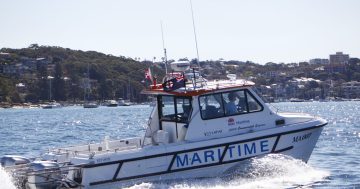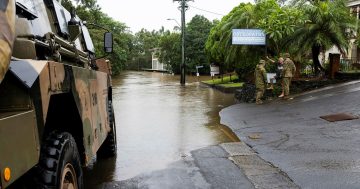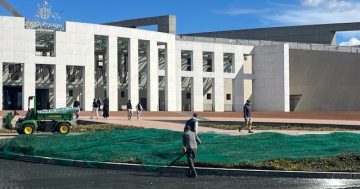By John Rozentals.
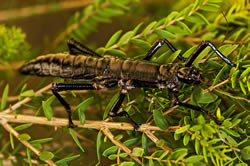
The phasmid: well on the road back. Image: Ian Hutton.
Lord Howe Island is packed with strange happenings and strange stories, probably none stranger that the rediscovery of its unique stick insect, aka tree lobster, phasmid or, technically correctly, Dryococelus australis, existing as a lone colony of just 24 insects on a forlorn, windy cliff-face on Balls Pyramid, some 23 kilometres south-east of Lord Howe Island proper.
The phasmid — we’ll stick to that nomenclature both for simplicity and because that’s what the Lord Howe Island locals mainly call them — was thought to have been made extinct in the early 1920s by black rats deserting the grounded SS Makambo.
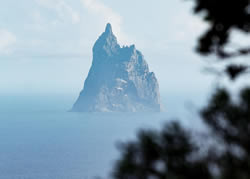
Image: Balls Pyramid: wasn’t climbed until the mid-1960s. Jackson Arkadieff.
And so a line was drawn on the existence of the phasmid — until 1964, when a intrepid party of rock climbers found a dead specimen on Balls Pyramid.
But it wasn’t until the early 2000s that the colony was found on the rocky Pacific outcrop and not until 2003 a breeding pair was transferred to Melbourne Zoo, where the scientists had hatched some 13,000 phasmid eggs and sent viable eggs to several zoos around the world.
Not that all Lord Howe locals are that pleased about the thought of a phasmid comeback and there are stories of hordes of the insects, which can measure up to 20 centimetres in length virtually taking over houses, eating everything in their path, and making plenty of noise doing it.
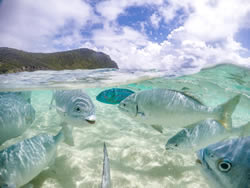
A literal flotilla of fish prepares to be fed at Neds Beach. Image: Jackson Arkadieff.
Evidence suggests, though, that phasmids are herbivores who eat a very limited range of leaves.
I discovered the fascinating story of the phasmid at the Lord Howe Island Museum (www.lhimuseum.com) on a short, very recent trip to the World-Heritage-listed island — my first venture there — largely under the guiding hand of Libby Grant and Mark McKillop, the husband-and-wife team who have been the long-serving managers of the very small and very exclusive Capella Lodge (www.baillielodges.com.au), which you’ll read much more about over the next couple of weeks.
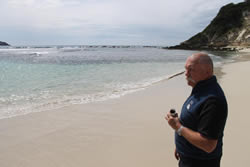
Mark McKillop: getting ready to feed the fish at Neds Beach.
The museum, run by the Lord Howe Island Historical Society and with obvious input from the likes of the late Ian Kiernan AO, is an excellent one, simply packed with relics and information.
You’ll do well to explore its rich bounty of resources in less than a couple of hours — and even better to completely miss the scalding assault of its appalling coffee.
Balls Pyramid, a 562-metre high volcanic remnant, wasn’t climbed until the mid-1960s and, despite the quite extraordinary offering of marine and bird life the world’s largest seastack remains off limits to most tourists.
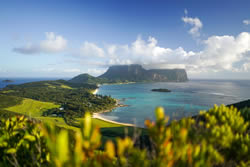
Lord Howe Island: what it’s all about. Image: Jackson Arkadieff.
Local boat operators will take you there, but make sure that your sea legs are up for a solid workout.
Better to stick with a boat journey and snorkelling exercise through the much more sheltered lagoon. The snorkelling is apparently divine with literally hundreds of fish wending their way through the world’s southernmost coral reef.
There is plenty to do on Lord Howe Island, starting with a veritable network of walking tracks, ranging from the most simple to testing and exhausting hikes to the summits of the island’s two main landmarks, Mt Gower and Mt Lidgebird.
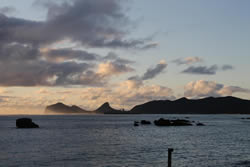
Lord Howe Island: a piece of paradise.
And if you don’t mind getting your feet wet — just a little bit wet — try feeding the fish at the usually very calm Neds Beach, on the island’s north-east.
Participants can grab some food and watch a literal frenzy of mullet, kingfish, etc descend of them. There’s plenty of golden sand, warm water and, probably best of all, total quiet except for gentle breezes and lapping of waves.
The population of Lord Howe Island is maintained at about 300, with a maximum of 400 tourists at any particular time.
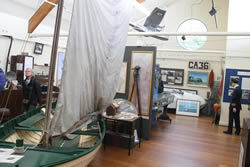
Lord Howe Island Museum: simply packed with relics and information.
Descendants of the original settlers hold a special place, and there does seem a bit of a feeling that the descendants do get some special treatment — but I guess that they should, too, and a quick trip to the local bowling or golf clubs seems to settle matters quickly enough.
And what of the descendants of the rats that very nearly put an end to the phasmids? They’re the current subject of a most intensive eradication campaign. Let’s hope it works — as I’m sure do the native wood-hens which have been rounded up and placed in safekeeping for the exercise that does involve an element of baiting.
But don’t worry. The baiting doesn’t seem to be a worry for tourists.
For general information about Lord Howe Island, visit www.lordhoweisland.info and www.visitnsw.com.


